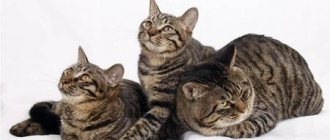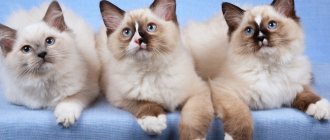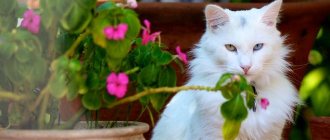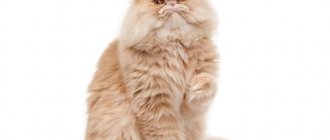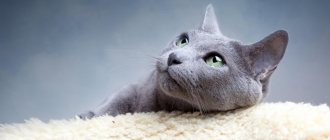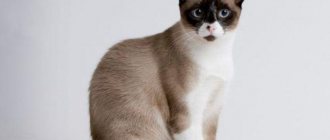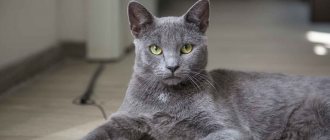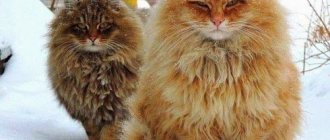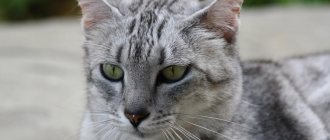History of the Chinese Li Hua breed
The origin of the breed is not precisely clear, so the version of self-domestication of the wild mountain cat is widely used.
Li Hua is considered one of the oldest Chinese breeds of domestic cats. In Chinese writing, the name of the breed Li Hua Mao looks like 狸花猫 and is literally translated into English as Fox Flower Cat; it is difficult to adequately translate this name into Russian. Internationally, the breed name Dragon Li is used to highlight the cat's origins and evoke associations with ancient Chinese culture. Li Hua Mao cats are mentioned in ancient Chinese texts and have lived throughout much of China for centuries. At the moment, in its historical homeland of China, this breed is very popular, although it is small in number. The cat of this breed became the central theme of the literary legend “Li Mao Huang Tai Tzu”, as well as the hero of the television series.
December 30, 2003 – January 6, 2004 the breed was demonstrated at the international exhibition in Beijing as an experimental one. In 2005, a standard was developed within the CAA (Cat Aficionado Association). In 2005, a cat named Needy (owner Da Han) took 1st place in his class and became a CAA champion. Since then, the breed has gained international recognition and aroused wide interest among felinologists. In February 2010, the breed was officially recognized by the CFA for showing in the Other class.
In October, two Chinese Li Hua Zhong Guo and Nao Nao were brought to the United States (Palm Springs, California), and two more arrived in March 2011 - Seng Hua (Sam), living in Georgia, and Dee Dee (South Dakota) .
Today the breed is very rare and it is almost impossible to acquire Li Hua Mao outside of China.
Appearance of cats of the Chinese Li Hua breed
The physique of these cats is muscular, the body is strong and slender, rectangular in shape with a wide chest. Size is medium to large. Males weigh at least 5 kilograms, cats - at least 3.5 kg. The body is longer than it is tall; when viewed from the side, the back should be almost straight. The limbs are proportional to the body, medium in size, straight, strong and muscular.
The front legs are the same length as the hind legs, or slightly shorter. The paws are large, oval, wide, with five toes on the forelimbs and four on the hind limbs. The head is elongated, the forehead is rounded. The ears are medium in size, wide at the base, rounded at the tip. The tail is long, but slightly shorter than the length of the body, thick at the base and gradually tapering to the tip. The eyes are large, almond-shaped, green or yellow, set slightly obliquely (the outer corner of the eye should be higher than the inner corner). There are black dots near the corners of the mouth, creating the effect of a smile.
The coat is short, silky, smooth, soft, with a weak undercoat, dense and double-layered. Males are tougher than females.
Only one color is recognized: brown broken mackerel tabby (black brindle tabby). There are black stripes on the head, dark spots on the abdomen, the tail is colored with dark rings, and the tip of the tail is black. There must be at least one continuous necklace-shaped stripe across the chest. Stripes extend from the outer corner of the eye and the lower part of the cheeks and continue to the neck.
The legs are covered with black rings above the wrist, below the wrist they are colored brown. The tabby pattern should be clear and bright, the coat should be ticked, that is, each individual hair is colored with encircling stripes, black at the root, light in the middle and brown at the end.
Representatives of the Li Hua breed develop slowly and fully mature only by the age of three. You can buy kittens after they reach twelve to sixteen weeks of age, when they are already strong enough for travel and exhibitions.
Disadvantages are: excess fat, disproportionately large ears, too wide or too narrow forehead, outer corner of the eye not higher than the inner corner, unclear fur pattern.
Disqualifications: Overbite, eye color other than yellow, green or brown, extra toes, tail defects, long or curly coat, white paws, white muzzle, no black tail tip, light nose, no necklace stripes on chest.
Li Hua, Li Mao, Li Hua Mau, Li Hua Mao, Dragon Li
Story
The Dragon Li, or Chinese Li Hua, is descended from the Chinese mountain cat, which over the centuries has adapted to living with humans (this is called self-domestication). This version of the origin is still sometimes disputed, although it could not be completely refuted, since it is traditionally believed that all cats descended from the wild African cat. In any case, the breed really belongs to the ancients, since the first mentions of these cats date back to the first millennium BC.
Thus, we can say that the Chinese Li Hua is an aboriginal breed, which in the process of its development went through a period of domestication, and in more modern times was subjected to systematic breeding. Despite its popularity in China, this breed is considered rare, and, accordingly, these cats are expensive, especially outside their native country.
To roughly understand how rare they are, it is enough to cite just one fact - as of 2021, there were 4 purebred Li dragons in the United States. And this is in a country with a population of 250 million people. Chinese Li Hua is the hero of many legends and traditions, and is also mentioned in other works of folklore. Today the breed is recognized by the International Cat Fanciers Association and the Chinese Cat Fanciers Association.
She was first presented in 2004, at the Beijing exhibition, where American breeders learned about her. Several individuals were transported to the USA, and after just over 2 years, experts presented standards for the Li Hua breed. The New Breeding Association of the United States registered these cats in 2010.
Description
A rare and outstanding breed of cats, the Li Hua is a real hunter, a wild cat that came from time immemorial. At the same time, they are kind and affectionate with their family, and merciless, fearless in a fight. Possessing high intelligence, Li Huas love to observe those around them, can open cabinet doors and are well oriented in the area.
The breed has a large build, powerful bones, but is not devoid of purely feline grace and ease of movement. The paws are of medium length, muscular and strong, the ears are medium, the muzzle is wedge-shaped, slightly elongated. The average lifespan has not been established due to the small number of individuals, but by default it is believed that these cats, like others, live about 15 years.
Personality
Since the Chinese Li Hua Mao (this is another name of the breed), descended from wild mountain cats, it carries the genetic memory and primitive instincts of these animals. Therefore, if you live in a private house, you can be sure that your pet will be incredibly happy about it. He will climb trees, bask in the grass in the sun, hunt mice and birds - he is a wonderful hunter, by the way.
In relation to the owner and members of his family, the Chinese Li Hua shows affection and friendliness, and is always ready to warm loved ones with its warmth. However, he has an independent character and intelligence, if we were talking about a person, they would say about such a person - a strong personality. Thanks to inner confidence and strength, the cat has patience and calmness, and therefore normally perceives other pets. But - only if it is not a parrot, fish or guinea pig, since the li hua will definitely see prey in them.
Children and strangers are treated calmly, without negativity
They love and appreciate attention from their owners, and worry if they don’t receive it. Also, the Li Hua cat becomes strongly attached not only to people, but also to a place, and therefore adaptation to a new home is difficult.
Cat behavior
Due to its lifestyle and habitat, this breed is rarely found in nature. Unfortunately, the study of cats was suspended in 1985. At that time, it was based on observations made in a Chinese zoo, where 34 representatives of the breed lived permanently.
A characteristic feature of the behavior of the “Chinese” (kittens, whose photos are fascinating and touching, behave almost the same as adults) is their nocturnal lifestyle. Maximum activity occurs at night and morning. Representatives of this breed prefer to stay separately - females and males live in different places. Their burrows also have significant differences. For example, a female’s home is protected and quite reliable.
In order to achieve maximum results when catching prey, Chinese cats rely entirely on their hearing. Thanks to artificial research, it was found that representatives of the breed are able to track clatter and moles while they move at a distance of 5 cm underground. Cats of this breed dig out their prey very quickly.
Conservation and study
The peak of study of this breed came from 1973-1985, when 34 cats were selected to be kept in a zoo to study the animal. The data collected at that time is the only information about this species of animal.
It is one of the top five most endangered felines and is listed on Appendix II of CITES.
Such a sharp decline in population is associated with a decrease in habitat due to human activity.
Chinese cats, by intuition, are accustomed to sharpening their claws much more often than other representatives.
One reason is the use of zinc salts as a way to get rid of rodents. But cats that ate poisoned rodents also died. After studying the drugs and confirming that they are harmful to all mammal species, the use of zinc in soybeans has been reduced. But it was never possible to restore the Chinese cat population.
Protecting such a beautiful endemic is a human responsibility. If you do not deprive it of its natural habitats, do not carry out work in the mountainous areas of Tibet and do not densely populate the Chinese steppes, then the extinction of the mammal can be successfully prevented.
How to keep a Dragon Lee cat - care rules
Wool. Although the animal has a short coat, it still needs to be looked after. To prevent furniture in the house and clothing from becoming covered with small cat hairs, it is recommended to carry out daily brushing. Since the cat loves attention, he will be happy about it. This procedure is especially necessary when the animal begins to shed. Bath a cat with dragon eyes once every three months, or more often if it becomes dirty. To avoid drying out the skin and other washing problems, it is recommended to choose only proven and high-quality shampoos intended for animals. This is due to the fact that the acidity of the skin of people and cats is different, and if you do not follow this rule, you can give your pet itchy skin. Shampoos come in both dry and liquid form. Among the former, the most popular is “Trixie Trocken Shampoo” from the German manufacturer TRIXIE Heimtierbedarf GmbH & Co KG; a liquid product can be 8 in 1 “Perfect Coat”. After the animal is washed, it must be thoroughly dried with a towel or hairdryer, since Li Hua cats cannot tolerate drafts and can get sick. Well, there is no question of letting such a pet outside even in warm summer weather.
Ears. Over time, secretions may accumulate in your cat Li Hua's ear canals, which can lead to blockages and inflammation. To avoid this, it is necessary to clean your pet's ears once a week with products specifically designed for this purpose. You can use the drug “Nature SaniPet”, which is applied to a cotton swab with a limiter. These cotton swabs are used to clean children's ears; they do not damage the eardrum. AVZ Bars or Hartz lotion, which contains aloe and lanolin, have proven themselves to be quite good. To prevent inflammatory processes in the ears of an animal, you can take the Auricap spray.
Cats' eyes need to be cleaned regularly with special products. For example, you can take Cliny C lotion (which contains silver ions that serve as disinfectants) or SaniPet, which allows you to remove morning discharge from the eyes of an animal not only for hygiene purposes, but also acts as an anti-inflammatory and antiseptic agent. All such drugs will help eliminate tearing and swelling of the eyelids.
It is important to remember that each eye is wiped with a separate cotton pad, which is moistened with lotion. If you cannot buy such a hygienic product, then herbal decoctions or strong tea leaves will do.
The claws of Dragon Li cats are trimmed once every 3-4 weeks, but only for those that are not outdoors.
In another case, the animal has many opportunities to solve this problem on its own. Only a couple of millimeters are cut off, since a blood vessel goes next and, if you hit it, you can cause incredible pain to your pet and it is unlikely that he will allow you to repeat this procedure. If you are not confident in your skills, you should consult a veterinarian.
Nutrition. Even in nurseries, the Li Hua cat is fed both dry and wet food. Their super premium class is selected, for example, the English Arden Grange, the Canadian 1st Choice (Fest Choice) or the like. Many owners teach their pet to eat natural food, consisting of lean meat, sea fish, dairy products, eggs, a small amount of cereals and vegetables. But unlike ready-made food, the owner will have to take care of vitamins.
General care tips. It is better to choose a vertical scratching post, because this type of device (for example, plant trunks) is more natural for cats. It is advisable that a rope made of natural fibers be wound around it. If the animal does not know how to use a scratching post, then you can drop a couple of drops of valerian on it.
A cat of any breed should have 2 bowls, one for water or other liquid, the second for food. You should immediately choose a tray with high sides so that when toileting, the cat Dragon Lee does not spill the litter on the floor.
How to choose the right kitten
Buying a Chinese Li Hua cat is quite difficult, because it is found only in its homeland and in the USA. Even in China it is not widespread, there are only a few nurseries there. Prices for kittens start at $1,000, and the cost of shipping the animal also falls on the buyer.
When choosing a Li Hua, you need to be very careful, because the breed is similar to an ordinary yard cat. You cannot trust sellers who post advertisements for sale on virtual bulletin boards - most often they are scammers. They do not have documents confirming their pedigree or vaccination certificates.
Those who have agreed to purchase a Chinese cat from a breeder from China or America need to make sure that the pet matches the description of the breed and is absolutely healthy. This can be judged by the following signs:
- the cat is active, playful, makes contact;
- he has clean eyes and ears;
- he is moderately well-fed;
- there are no bald spots on the body;
- the abdomen is soft, without signs of bloating.
Kitten care
Chinese kittens should not be separated from their mother before 12 weeks of age. Some breeders do not release them to new owners until 4 months. By this time, the babies are already accustomed to the tray and scratching post, and can eat from a bowl independently.
They can be fed with chopped lean chicken, turkey, veal, rabbit with the addition of vegetables. Also included in the kittens’ diet is low-fat cottage cheese, boiled eggs, and cereals.
Motor activity is very important for harmonious development. A cat needs a lot of space to run and play. Caring for her includes regular cleaning of her eyes and ears, combing her fur and shortening her nails.
Interesting Facts
Interesting information about the breed will help you get to know the dragon better:
- These animals are distinguished by their independent character, but show exceptional devotion to their owner.
- Chinese cats are smart and can be trained. One famous person from China trained his pets to bring him newspapers.
- In China, these animals are sometimes taken to wedding ceremonies.
- Chinese cats grow very slowly, so breeders do not give away kittens at an early age, but wait until they are stronger.
- The Chinese believe that li hua can protect the home from evil spirits.
Munchkin
This breed differs from others in that its representatives have short legs. As a rule, they are two to three times smaller. That is why this breed is colloquially called the dachshund. Cats received this distinctive feature through the process of mutation, which sometimes happens to domestic animals. This is their main difference. Other external features of individuals of this breed have not changed. The spine and its flexibility remained the same.
Munchkins are intelligent cats, they are pleasant to talk to and easy to care for. There are representatives with both long and short hair. There are cats of various colors and combinations, and you can also see a medallion.
This breed is unique not only with its paws. Cats with short legs have a round head and specially shaped eyes, a long or short nose, and a protruding chest.
Munchkins are very popular among people. They are especially adored by children. A good friend and loyal comrade - what could be better?
History of the discovery of the species
It is not known for certain where the animals came from; they approximately inhabited the territory of China long before the appearance of people and lived in desert areas. The separation of the Chinese and European (forest) cats occurred 230 thousand years ago. The cat was first described by the French zoologist and naturalist Henri Milne-Edwards in 1892. These animals lived in China long before the appearance of pets in Europe, where they were brought after the opening of economic borders.
Today, the Desert Cat is a small species, numbering from 2,500 to 10,000 adult individuals according to various sources, and these data are inaccurate. Not all animals have been domesticated by humans; small groups live in the remaining undeveloped areas of China.
Today they are facing extinction, as residential and industrial buildings occupy new territories every day, leaving no room for wildlife.
Proper care and feeding
Chinese Li Huas love free space, so it is preferable to keep them in a private house or a spacious apartment, where they will have their own place. If such an animal is given freedom, it will never go far from home, since it prefers warm rooms rather than cold streets.
Caring for this breed is extremely easy. You only need to comb the coat a couple of times a week, and during the shedding period it is better to do this daily. You should bathe no more than 2 times a year. Since Li Hua are sensitive to drafts, they must be dried with a hairdryer after water treatments. And also in cold seasons, it is best to dress these cats in special clothes so that they do not catch a cold.
Every month it is necessary to trim the nails, but this is only if the pet is completely indoors and does not go outside. You should only cut off a couple of millimeters so as not to touch the blood vessel. Periodically, you need to wash your ears and eyes with a cloth soaked in warm water.
Due to the fact that such cats had wild ancestors, they love to sharpen their claws, so it is imperative to purchase a scratching post for them. It is best that it be vertical and have a rope made of natural fibers. To train your pet to use a scratching post rather than wallpaper or furniture, you can drop a couple of drops of valerian on it. It is advisable to purchase a tray with high sides and keep it clean.
Breeders prefer to feed such cats with premium ready-made dry or wet food. But if you wish, you can accustom your pet to natural products. In this case, it is necessary to add vitamins to the diet. Chinese cats have an excellent appetite and their diet should be balanced and enriched with proteins. This breed has no tendency to be overweight.
It is advisable to feed Li Hua at the same time. Adults need to be given food twice a day. It shouldn't be cold or hot. If the diet is mixed, then natural food must be served separately from prepared food. For example, feed dry food in the morning and natural food in the evening.
You can feed:
- lean meat;
- vegetables;
- porridge;
- offal;
- boiled sea fish;
- low-fat and natural dairy products (infrequently);
- soft bones and cartilage (not fish or chicken).
Meat, vegetables and cereals must be boiled before serving. Sweets, pork, sausages, fatty dairy products, salty foods and fruits should be excluded from the diet. The animal should have two bowls - for food and water. Cats should always have access to quality drinking water.
Li Hua have relatively good health and immunity. In addition, this breed does not have pronounced genetic diseases. They are very sensitive to drafts due to the lack of undercoat, so they should always be kept warm. Once every six months, Chinese cats require examination by a veterinarian, as well as regular vaccinations. Be sure to protect your pet's fur from insects and parasites. If all recommendations for care and feeding are followed, such pets can live 14-15 years.
Unfortunately, this breed has not become widespread and today there are very few of their representatives. It is quite difficult to purchase such an animal outside of China, since only there are several breeders breeding this breed. Therefore, the prices for Li Hua kittens are quite high.
Li Hua, Li Mao, Li Hua Mau, Li Hua Mao, Dragon Li
Story
The Dragon Li, or Chinese Li Hua, is descended from the Chinese mountain cat, which over the centuries has adapted to living with humans (this is called self-domestication). This version of the origin is still sometimes disputed, although it could not be completely refuted, since it is traditionally believed that all cats descended from the wild African cat. In any case, the breed really belongs to the ancients, since the first mentions of these cats date back to the first millennium BC.
Thus, we can say that the Chinese Li Hua is an aboriginal breed, which in the process of its development went through a period of domestication, and in more modern times was subjected to systematic breeding. Despite its popularity in China, this breed is considered rare, and, accordingly, these cats are expensive, especially outside their native country.
To roughly understand how rare they are, it is enough to cite just one fact - as of 2021, there were 4 purebred Li dragons in the United States. And this is in a country with a population of 250 million people. Chinese Li Hua is the hero of many legends and traditions, and is also mentioned in other works of folklore. Today the breed is recognized by the International Cat Fanciers Association and the Chinese Cat Fanciers Association.
She was first presented in 2004, at the Beijing exhibition, where American breeders learned about her. Several individuals were transported to the USA, and after just over 2 years, experts presented standards for the Li Hua breed. The New Breeding Association of the United States registered these cats in 2010.
Description
A rare and outstanding breed of cats, the Li Hua is a real hunter, a wild cat that came from time immemorial. At the same time, they are kind and affectionate with their family, and merciless, fearless in a fight. Possessing high intelligence, Li Huas love to observe those around them, can open cabinet doors and are well oriented in the area.
The breed has a large build, powerful bones, but is not devoid of purely feline grace and ease of movement. The paws are of medium length, muscular and strong, the ears are medium, the muzzle is wedge-shaped, slightly elongated. The average lifespan has not been established due to the small number of individuals, but by default it is believed that these cats, like others, live about 15 years.
Personality
Since the Chinese Li Hua Mao (this is another name of the breed), descended from wild mountain cats, it carries the genetic memory and primitive instincts of these animals. Therefore, if you live in a private house, you can be sure that your pet will be incredibly happy about it. He will climb trees, bask in the grass in the sun, hunt mice and birds - he is a wonderful hunter, by the way.
In relation to the owner and members of his family, the Chinese Li Hua shows affection and friendliness, and is always ready to warm loved ones with its warmth. However, he has an independent character and intelligence, if we were talking about a person, they would say about such a person - a strong personality. Thanks to inner confidence and strength, the cat has patience and calmness, and therefore normally perceives other pets. But - only if it is not a parrot, fish or guinea pig, since the li hua will definitely see prey in them.
Children and strangers are treated calmly, without negativity
They love and appreciate attention from their owners, and worry if they don’t receive it. Also, the Li Hua cat becomes strongly attached not only to people, but also to a place, and therefore adaptation to a new home is difficult.
Common diseases
Like other native cats, Chinese dragons do not have any health problems. These are hardy animals with strong immunity.
This breed is classified as short-haired, and therefore it is enough to comb the pet once a week. You can bathe once every 2 months or as needed. You also need to brush your teeth at least 3 times a week, trim your nails about once every 10 days, and clean your ears as they get dirty.
Chinese Li Hua Mao or Dragon Li, as they are also called, are very rare even in their homeland. In most countries, only connoisseurs have heard about them, and there is no need to talk about nurseries or the sale of kittens. Perhaps in the near future the situation will change in favor of furry dragons, because interest in everything Chinese is constantly growing.
Breed standard and character of cats
Likoi cats must meet the following standard indicators:
- Head:
wedge-shaped, with rounded features; the forehead is aristocratic, slightly convex, rather high and narrow. - Ears:
large, pointed tips, wide base, set high, little hair on the outside of the auricle. - Muzzle:
nose straight, neat; pads under the whiskers (whiskers) are dense, rounded; there is a pinch - a sharp transition under the cheekbones; the chin is neat, but strong, rounded; There must be a mask with no fur. - Eyes:
large, expressive, walnut-shaped, wide open; color – any, preferably golden. - Body:
Slim, muscular and flexible; fit, athletic, fairly elongated, generally light (foreign type). - Limbs:
slender, medium length, poorly covered with hair; The paws are oval-shaped, neat, the toes are quite long and thin. - Tail:
thin, shorter in length than the body. - Wool:
soft and pleasant to the touch; the undercoat is practically absent, while the guard hair grows throughout the body; its length varies, but is preferably short; The thickness of the hair depends on the season.
The color is roan, or, as it is also called, roan. This implies an even mixture of all-black hairs with all-white hairs throughout the body. Usually black wool is 30 - 70%, ideal when the proportion of colors is 50x50.
Males and females are quite easy to visually distinguish - males are larger, weighing 4.5 - 6 kg, while cats weigh 2 - 3.5 kg.
The nature
Likoy is an inquisitive, active, good-natured and very loyal pet. Despite their creepy appearance, these cats quickly endear you to their positive attitude, charisma and easy-going nature.
Lykoi are very attached to their owner. They accompany the owner everywhere and delve into all his affairs. If, in the cat’s opinion, someone is threatening the owner, Likoy is even capable of rushing to defense. It is not surprising that many compare them to dogs.
Cheerful fidgets will happily settle down comfortably at the feet of a loved one and spend the evening like this, giving tenderness and warmth. However, in general, these cats are very active and Lykoi will not be suitable for people who cannot provide them with sufficient active time.
Lykoi are sociable and fearless, so they get along well with other cats, dogs and other pets, often becoming the leader of the company. However, it is better not to keep Lykoya with rodents, birds, fish and other small pets. The cat will most likely perceive them as a hunting object.
Representatives of the breed, especially males, zealously defend their rights, which is why they sometimes experience mood swings. These cats behave reservedly with strangers. Once contact is established, they become much more open.
Captivity
The Chinese desert cat is listed in the Red Book, so keeping an animal at home is punishable by law.
Despite the prohibitions, you can find exotic animal babies on the black market. When purchasing a wild animal that is not adapted to living at home, you need to understand that improper care, territorial limitations and nutrition can lead to negative consequences.
A Chinese cat, accustomed to freedom and harsh natural conditions, can get sick and die in the house.
When feeding domesticated predators with natural products, the owner faces difficulties in selecting and balancing the diet, but for experienced breeders this is not a problem.
Li Hua: description of the breed
The Chinese cat is a strong, hardy, medium-sized breed. Adult cats weigh 5 kg, male cats 3.5 kg. The animal's back is straight, its tail is of medium length and tapers to the tip. The legs are muscular, the hind legs are longer than the front ones. The wide, oblong feet have 5 toes on the front paws and 4 on the hind paws. The cat has the ideal proportions of a predator. The neat muzzle is slightly elongated, but not pointed. Bright green or rich yellow, large and obliquely set eyes emphasize the image of wild ancestors.
What does a Li Hua mountain cat look like?
For your information! Because of the color of the eyes, the breed has other names - Li Dragon or Li Mao.
The ears are small and slightly curved at the ends. There are black dots at the corners of the mouth, making the cat appear to be smiling. Flat nose, brown or black.
A distinctive feature of the breed is its coat. She is a silky soft brindle. The coat is dense with a glossy sheen. Only one color is recognized - brown tabi. On the head, pronounced black stripes give the appearance of a bowler hat; the abdomen is covered with dark spots. The chest black stripes create a necklace effect. Also, stripes extend from the eyes and cheeks to the neck. In a purebred cat, the pattern should be bright and clear, and the hair should be black at the root, light in the middle, and brown at the end.
The cat world is very large, and a non-specialist can easily confuse a Chinese kitten with other felines, for example, with a yard tabby, as well as with the Maine Coon breed.
Important! The Chinese cat breed is an endangered species and is therefore listed in the Red Book. The breed has only brindle coloring
The breed has only brindle coloring
Advantages and disadvantages of the breed
Each breed has strengths and weaknesses. The Chinese cat is no exception. Pros of a mountain cat:
- devotion to the owner;
- easy character, which allows you to get along well with other pets;
- without aggression;
- does not require constant attention;
- strong immunity to diseases;
- high intelligence.
The disadvantages include:
- high price and difficulty in purchasing;
- development requires a spacious room;
- there are cases of negative attitudes towards children;
- Due to the striped color, it can be confused with another breed, so the purchase should be made by a professional.
Vaccinations and antiparasitic treatment
To maintain health, your Chinese cat should be vaccinated against infectious diseases in a timely manner. The first vaccination is carried out at the age of 3–4 months, repeated ones are done once a year.
Kittens must be vaccinated against the following diseases:
- rabies;
- calcivirosis;
- panleukopenia (distemper);
- chlamydia.
Vaccinations are given only to healthy cats. Deworming is carried out first. Chinese cats that are outdoors must undergo therapeutic and preventative treatment for fleas and other skin parasites.
Character
The Dragon Li is an affectionate and calm breed. Although these cats cannot be called independent, they are still less affectionate towards people than most breeds. Nevertheless, they easily make contact, are sociable and playful. Li Mao get along well with other animals in the house and do not show aggression. But cats of this breed do not get along well with children. They do not show aggression towards them, but they are not in a hurry to make friends, preferring to stay at a distance from them.
This breed is well suited for keeping in an apartment. Li Hua are moderately active, but quite calm. They do not refuse to play, but when they are at home on their own, they prefer to sleep peacefully in a secluded place.
Health
Chinese dragons are very strong and hardy cats with a good immune system. There are no characteristic genetic diseases noted in the breed, but this does not mean that they are absolutely disease-free. The average life expectancy due to the small number and maintenance in radically different conditions has not been established, but is estimated to be 14 - 15 years.
Nutrition, care
The species is considered poorly studied, since the animal does not make contact with humans and is nocturnal.
The rest of the time it hides in underground burrows with one exit.
Li Hua's cats need space
They lead a solitary lifestyle. The average territory area for one species is 10-15 square kilometers. A collision with another individual, regardless of gender (except for the rut), leads to a strong fight between animals.
It feeds on rodents and birds. Capable of digging out its prey from underground. Humans are the only threat to the animal.
Unfortunately, the Chinese cat breed receives the predominant percentage of dangers from humans. This is due to the constant hunting of its representatives and the spread of poisons dangerous to it.
The first and main reason for the decline in the population of this breed is the almost complete elimination of prey. Back in 1958, instructions were given to destroy all rats and rodents. This would significantly reduce the number of zokors, which posed a direct threat to livestock. The main chemical used to exterminate them was zinc phosphide.
This Chinese cat with big eyes, in addition to the animals presented, also consumes rabbits, pheasants and other representatives.
Features of temperament
When purchasing a cat, you should always know its characteristics. Li Hua will wait for the owner to take the first step when making an acquaintance, and only after showing friendliness on his part will he make contact. It is characterized by autonomy and independence.
He is distinguished by his devotion, but does not sit in his arms for a long time and does not get bored alone. Long-term lack of attention from the owner is hard to bear. Doesn't like small spaces; she needs room to move. She is very curious, but not trusting, so she will look at guests from afar.
An excellent hunter - gets rid of small animals, rodents and birds. If he feels forced, he will defend himself and use his teeth and claws - it is better to keep children away from him. Thanks to his innate intelligence, he can be taught to carry out simple commands. Does not tolerate change of environment well.
Description
Chinese cats are currently little studied; their habitat is desert areas. At the moment, Chinese cats are endangered. Due to overdevelopment in the Republic of China, natural habitats are suffering greatly. These cats are very sociable, affectionate, gentle and incredibly devoted to their owner. But due to the fact that cats were domesticated later than their European relatives, their character remained independent.
They treat children very patiently, but it is better not to have such a four-legged friend in a house where there are children. They get along well with other animals. These cats have not yet been studied well, so it is difficult to judge their pain; in general, the physiological component is normal.
They are not fussy about their care and do not require constant care and supervision.
The cat looks like this:
- The animal's height ranges from 27 to 35 cm, weight - from 3.5 to 5.5 kg.
- The body shape is elongated, proportionally muscular, with a large chest, not very long legs and a long tassel-shaped tail.
- Due to the peculiarities of the color (dots on the face), it seems that the fluffy is smiling. In combination with large expressive eyes it looks very cute.
- Puberty occurs at the age of three years. The kitten should not be separated from its mother until it reaches twelve weeks of age.
- This breed has not been subject to the intervention of scientists and has never been crossed with anyone, so it simply does not have genetic problems on this basis.
- The coat should be combed no more than once a week: the “Chinese” have practically no undercoat, and combing can damage the dense layer of coat.
- The animal should be bathed as needed, and scheduled bathing should be carried out no more than once a month.
Health and susceptibility to disease
Puberty in Chinese cats occurs at the age of 8–9 months. However, you should wait until at least 1.5 years for the first mating. Early pregnancy can result in miscarriage or undermine the health of the mother cat.
Li Hua has good health, since this breed has never been infused with other blood and was not created artificially. No hereditary diseases were found in its representatives. The average lifespan of a Chinese cat is 15–18 years.
The meaning of dragons in China
Throughout almost the entire history of China, dragons were revered in every settlement, village and city; an idol was erected in honor of the dragon king, incense was burned, and sacrifices were made to the deity.
The significance of this mythical creature in the life of the Chinese people is great, which is also proven by the fact that by the 7th century BC, images of dragons were found on all clothes, musical instruments, gates, sword handles, dishes, gates and other architectural structures.
The great influence of dragons on Chinese culture, mentality and education is proven by many folk sayings involving these creatures; moreover, the people always spoke about their emperor with the addition of the word “long”, this also applied to the personal belongings of the ruler, his offspring and some personal qualities.
In almost all dynasties, the imperial throne was called the “dragon throne”, and the state’s coat of arms was decorated with the image of a dragon. For wearing clothes with the image of this great creature by a commoner, he was subject to the death penalty.
During the time of the legendary ruler Fuxi, ranks and ranks were introduced in China, assigning each dragon patron. Higher officials (7th rank) wore robes and robes decorated with golden moon dragons with 5 claws on their paws. On the attire of lower ranks there was a Mann dragon with four claws. In those days, the hierarchy of dragons depended on the number of claws on their paws and the ability to fly. At the highest level were flying dragons, they had dragon spirits subordinate to them, then earthly ones, they once flew, but lost this ability. The list was completed by underground creatures; they were charged with the duty of guarding treasures.
Mythological creatures dragons also influenced Chinese zoology, and more precisely the origin of many species of amphibians.
It was argued that more than 10 thousand creatures descended from dragons, including feathered, scaly, furred, armored and others. Every inhabitant of the Celestial Empire clearly understood the character and habits of dragons, he knew that this long, scaly creature could hide and be invisible, it soars into the sky on the days of the spring equinox, and dives into the abyss on the days of the autumn equinox. In winter, the dragon hibernates.
In modern Chinese society, the influence of the dragon on the people has weakened a little, but still, the Chinese revere and love its image, it is found in everyday life and art, the image of this powerful creature to this day inspires residents with a certain reverent fear. Everyone believed in the existence of dragons in China, not only common people, but also emperors, generals, mandarins, artists, writers and even serious scientists.
According to legend, there were countless dragons in China, ranging from tiny to gigantic ones.
How to choose the right kitten
Buying a Chinese Li Hua cat is quite difficult, because it is found only in its homeland and in the USA. Even in China it is not widespread, there are only a few nurseries there. Prices for kittens start at $1,000, and the cost of shipping the animal also falls on the buyer.
When choosing a Li Hua, you need to be very careful, because the breed is similar to an ordinary yard cat. You cannot trust sellers who post advertisements for sale on virtual bulletin boards - most often they are scammers. They do not have documents confirming their pedigree or vaccination certificates.
Those who have agreed to purchase a Chinese cat from a breeder from China or America need to make sure that the pet matches the description of the breed and is absolutely healthy. This can be judged by the following signs:
- the cat is active, playful, makes contact;
- he has clean eyes and ears;
- he is moderately well-fed;
- there are no bald spots on the body;
- the abdomen is soft, without signs of bloating.
Kitten care
Chinese kittens should not be separated from their mother before 12 weeks of age. Some breeders do not release them to new owners until 4 months. By this time, the babies are already accustomed to the tray and scratching post, and can eat from a bowl independently.
They can be fed with chopped lean chicken, turkey, veal, rabbit with the addition of vegetables. Also included in the kittens’ diet is low-fat cottage cheese, boiled eggs, and cereals.
Motor activity is very important for harmonious development. A cat needs a lot of space to run and play. Caring for her includes regular cleaning of her eyes and ears, combing her fur and shortening her nails.
Education and training
The Chinese claim that a smarter and more pliable breed cannot be found. Li Hua are smart and grasp everything literally on the fly. A cat can easily be taught various commands. The main thing here is to find the right approach. These cats are very loyal to their owners and try to please them in everything. Perhaps this is precisely the secret of such pliability to training.
There is no need to raise a cat of this breed at all. The mother cat herself accustoms her children to the tray and to the designated place for eating.
Cat character
| This article or section needs revision. Please improve the article in accordance with the rules for writing articles. |
| Chinese cat | |
| Scientific classification | |
| Kingdom: | Animals |
| Type: | Chordata |
| Class: | Mammals |
| Squad: | Predatory |
| Family: | Felines |
| Subfamily: | Small cats |
| Genus: | Cats |
| View: | Chinese cat |
Latin name
Felis bieti Milne-Edwards, 1892
Area
International Red List Vulnerable species IUCN 3.1 Vulnerable: 8539
The Chinese name for this type of cat is “huang mo mao,” which translates to “yellow-haired cat.” Two common nouns were used in their name: “Chinese Desert Cat,” indicating its habitat in desert areas, and “Chinese Mountain Cat,” indicating cases of its rise high in the mountains.
The Chinese cat, endemic to China, is one of the least studied felines. This animal is slightly larger than the domestic cat, and upon first meeting it appears to be an enlarged specimen of the European wild cat (Felis silvestris), so similar are they. Its size and weight resembles a jungle cat, however, the legs of a Chinese cat are shorter.
According to geneticists who studied the mitochondrial DNA of cats, the separation of the lines of the forest cat (Felis silvestris) and the Chinese (Gobi) cat (Felis bieti) occurred 230 thousand years ago.
Chinese or Gobi gray cat and description
August 16, 2021 Lyudmila page » Wild cats 264
Chinese cat, Chinese desert cat, Chinese mountain cat, Gobi gray cat - all these are the names of one cat.
It belongs to the subfamily of Small cats (Felinae), the genus of cats (Felis), the species of Chinese cats (Felis bieti - in honor of the French missionary and naturalist Felix Bie).
The Chinese themselves call this cat “huang mo mao”, which literally means: “a cat that lives in a desert area with sparse vegetation.” Since 1992, this cat was officially renamed the Chinese mountain cat, because... now it is found only in the mountains of China.
Appearance of a Chinese gray cat
This cat is slightly larger than the average domestic cat and is very similar in appearance to the European wild cat (Felis silvestris).
The cat's body is stocky. The body length of the Chinese cat is from 1 to 1.5 meters. A third of the length (from 29 to 35 cm) is on the tail. Height at withers is from 30 to 35 centimeters. Weight ranges from 4.5 to 9 kilograms. The legs are short relative to the body.
The head is wide with large ears with black tassels (up to 2.5 cm) at the ends. The muzzle is round with a small nose and green eyes.
The tail is thick with 4-6 dark transverse rings, like a raccoon. The tip of the tail is black.
The coat is long and dense with a good thick undercoat. By winter it becomes longer and thicker. The color of the fur coat is gray-yellow in summer and gray-brown in winter. The lower part of the body is lighter than the back.
Habitat and lifestyle of the Chinese cat
The Chinese cat lives mainly in steppe and mountainous regions in northwestern China and southern Mongolia and Tibet, in the most extreme climatic conditions, where in summer the temperature rises to 40 degrees, and in winter it drops below 30 degrees due to strong winds. They prefer alpine meadows and areas covered with bushes. In the mountains they have been seen at altitudes from 2,800 to 4,100 meters above sea level.
The Chinese cat is a nocturnal animal that leads a solitary lifestyle. She is very careful and it is almost impossible to meet her in the wild. Females and males live separately. They spend most of their time in burrows. Moreover, females’ burrows are much deeper and more protected than those of males.
One cat occupies an area of about 12-15 km2.
Scientists studied all its habits from individuals that were in the zoo.
What does a Chinese cat eat?
The Chinese cat feeds mainly on rodents and small mammals: mice, rats, zokor, moles, gophers, marmots and rabbits. Sometimes they do not disdain lizards, birds (pheasant, partridge) and insects.
Thanks to their sensitive hearing, these cats find tsokors and moles by the sound of their movements underground. And having discovered prey, the Chinese cat instantly tears up the ground and catches rodents.
How does a Chinese cat reproduce?
During the breeding season (January to March), Chinese cats live together. Pregnancy lasts 2-2.5 months. Shortly before the kittens are born, the cat develops a hole or den in tree trunks.
Usually 2-4 cubs are born. Kittens grow quickly and at 7-8 months are already completely independent from their mother. At 8-12 months they can reproduce on their own.
Chinese cat population
In the wild, Chinese cats live from 10 to 12 years. Like all wild relatives, this cat suffers most from human activity. Thanks to the thoughtless and careless extermination of rodents in 1958 with the help of pesticides, many wild animals were poisoned along with the rodents.
For 20 years, the Chinese poisoned rodents with zinc phosphide until they realized that in this way they also killed all the carnivores that hunted these same rodents.
Also, because of the fur from which the Chinese sew traditional hats, the population of Chinese cats is sharply declining. Now the number of this cat barely reaches 10 thousand individuals.
Conservation status of the Chinese cat
To date, the Chinese cat is listed in the Red Book and in Appendix II of CITES. This is the only cat that is entirely Chinese.
Chinese cats do not pose any danger to humans and livestock. On the contrary, by increasing their numbers it was possible to do without 20 years of poisoning rodents and everything around them with chemicals. So, one thoughtless cry caused irreparable damage to all living things.
External standards
The Chinese dragon looks very strong and its body is well built. Adult males weigh 5−6 kg, the body weight of females is 3−4 kg, the length of the body including the tail is 85−90 cm, the appendage occupies a third of the part. Cat appearance standards:
- round head with convex cheeks;
- almond-shaped eyes;
- chin is flat;
- the width of the nose is equal to the size of one eye;
- thick neck;
- limbs of medium length;
- short, harsh coat.
On the large head, the cat’s fleshy cheeks stand out, large, wide ears are set with a slight tilt forward, crowned with small tassels. Large, slightly slanted eyes should have a yellow iris. Animals with a green tint are also allowed at exhibitions, but they are valued much less. The wide nose is black or dark brown; light spots and stripes are not allowed. A well-developed chin appears flat when viewed in profile. The transition from forehead to nose is almost invisible.
The head sits on a short massive neck, the chest is quite deep and wide, very strong. Although the body of the Chinese cat is dense, it is built compactly and gracefully. All muscles are clearly visible under the smooth coat. The tail and limbs are of medium length, the paws are large, the pads are black or dark gray. Undercoat grows between the toes, and the claws retract when at rest.
The fur of the Chinese cat is short and quite hard. In a healthy animal it should have a glossy sheen. Only two types of color are allowed: golden brown or chocolate tabby. Dark stripes or spots are clearly visible on a light background; the letter “M” can be distinguished on the forehead. The neck is covered with a pattern resembling a necklace, the eyes are outlined in black, and the tail has evenly distributed rings.
These animals have rather large and almond-shaped eyes.
The camouflage appearance of "Lee's Dragons" allows the cats to be invisible to unwary prey in the wild, but it appears deceptively generic to humans. However, Li Huas are not deprived of their own charm, and the Chinese cat breed standard is determined by the following parameters:
- The back is straight, the body is proportional and slightly elongated.
- The coat is dense, but soft and tactilely pleasant, the undercoat is poorly developed.
- The head is slightly elongated, the forehead is round. Due to the peculiarities of the color, it seems as if the cat is constantly smiling.
- The eyes are almond-shaped, large, and located at an angle. The color contrasts with the coat, mainly taking on shades of green and yellow.
- The ears resemble isosceles triangles with medium-sized rounded tops.
- The legs are muscular and straight. The hind ones are longer or the same length as the front ones. There are 5 toes on the front paws and 4 on the hind paws.
Description of the appearance of the dragon cat
The Chinese cat resembles a wild European cat - large, with gray striped hair. In winter, its coat is yellowish-gray, and in summer it is dark brown. The pattern on the coat is striped.
The physique of these cats is muscular, the body is strong and slender.
Size – 84-90 centimeters in length. The tail makes up one third of the body length. A cat has 4-6 transverse dark stripes on its tail. The tip of the tail is crowned with a dark tip. The body is proportional, with short but powerful legs. Thick fur grows between the toes. The claws are retractable.
The ears are large and crowned with long tufts. Its appearance resembles a miniature lynx.

